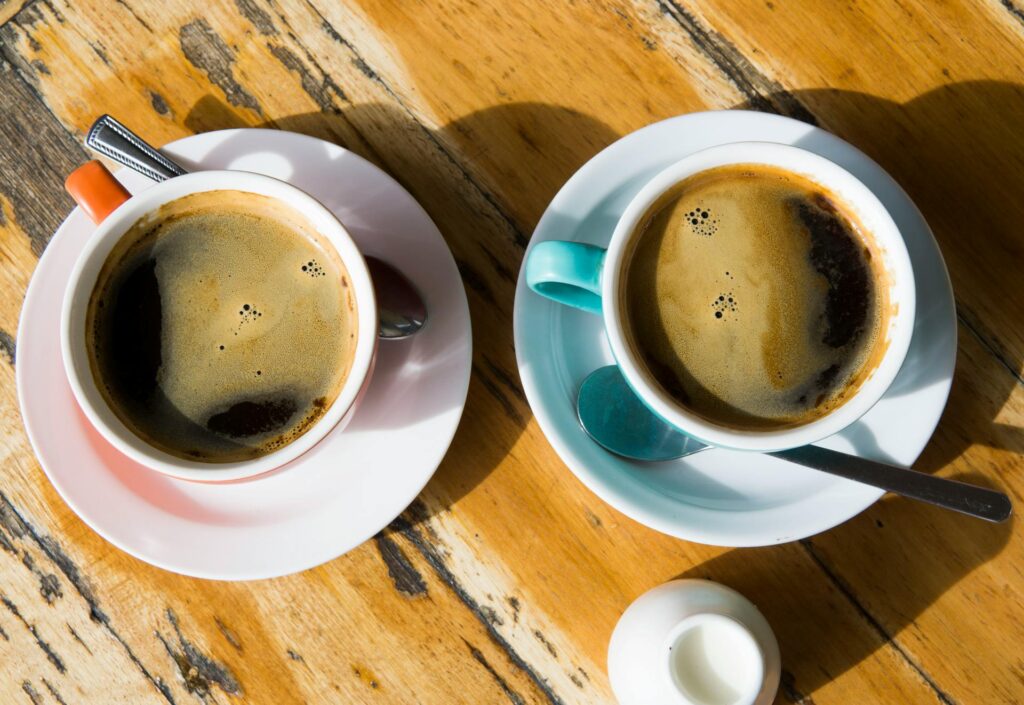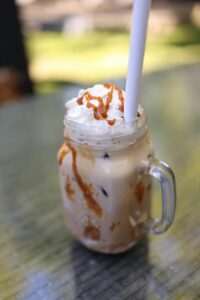Ever wondered how coffee pros judge beans the way sommeliers swirl wine? That’s where coffee cupping comes in.
Cupping is simply the practice of smelling, slurping, and tasting coffee with a methodical approach.
It’s not complicated or elitist—it’s just a structured way to notice what’s already in your cup.
For beginners, it’s a game-changer. You’ll learn how to tell fruity from nutty, smooth from sharp, and average from exceptional.
Once you try it, your morning brew stops being just “coffee” and starts becoming an experience!
What is Coffee Cupping?
Coffee cupping is the coffee world’s version of a taste test with rules, and it’s been around for over a century as a way to fairly judge beans from all over the globe.
Originally used by traders and roasters to evaluate shipments, the practice is now a standard in coffee labs, cafés, and even at kitchen tables for curious hobbyists.
The idea is simple: line up different coffees, prepare them the same way, and then taste them side by side so nothing gets lost in fancy brewing methods or marketing claims.
Roasters rely on it to spot defects, compare harvests, and make sure the bag you buy delivers what it promises.
Baristas use it to train their palates so they can talk about coffee beyond “strong” or “smooth.”
Even home brewers find it useful because it opens your eyes, or really, your taste buds, to just how wide the flavor spectrum can be.
This is where flavor notes come alive: citrusy brightness, nutty comfort, chocolatey richness.
Cupping ties them together into a language that helps you understand not only what you like but also why you like it, and that’s the key to choosing better beans and truly enjoying your daily cup.
Essential Tools and Setup
Must-Have Gear
Cupping doesn’t require a science lab, but a few basics make all the difference. Here’s what you need on the table:
- Fresh whole beans – stale coffee ruins the fun before it starts.
- Burr grinder – gives you an even grind so every cup is judged fairly.
- Scale – keeps your measurements consistent instead of guessing.
- Kettle – gooseneck is nice, but any kettle with hot water works.
- Cupping bowls or mugs (6–8 oz) – uniform size makes comparisons easier.
- Deep spoons – for breaking the crust, skimming, and slurping. Keep extras handy if more than one person is tasting.
Water and Grind Settings
Water can make or break your tasting. Aim for 200°F (about 93°C)—hot but not boiling, so you don’t scorch the grounds.
Grind your coffee medium-coarse, similar to kosher salt, which allows the coffee to steep evenly while keeping particles from turning bitter.
Too fine and it’ll be harsh, too coarse and it’ll taste thin. Think “Goldilocks zone” but for grind size.
Home-Friendly Setup
Don’t have official cupping bowls or a fancy gooseneck kettle? No problem. Regular kitchen mugs work fine, and a sturdy tablespoon doubles as a cupping spoon.
Even a basic electric kettle gets the job done. The point isn’t perfection, but it’s consistency. As long as you treat each sample the same way, you’ll be able to taste the differences clearly.
In fact, starting with a DIY setup can be more approachable, since it feels like you’re experimenting in your own coffee lab without dropping a ton of cash.
Step-by-Step Coffee Cupping Process
Step 1: Grind & Smell – Dry Aroma Notes
Start by grinding your beans to a medium-coarse texture, like kosher salt. Don’t rush this part because the smell of freshly ground coffee tells you more than you think.
Stick your nose close to the grounds and take a big whiff. Notice if it’s fruity, nutty, chocolatey, or earthy. This is your first clue about what’s waiting in the cup.
Think of it like reading the cover before opening the book.
Step 2: Bloom & Fragrance – Adding Hot Water
Next, pour hot water (around 200°F / 93°C) over the grounds until each cup is about three-quarters full. The coffee will “bloom,” releasing bubbles of trapped gas and filling the air with fragrance.
Lean in again and smell. This aroma is often fuller and rounder than the dry grounds.
Compare the two—sometimes they match, sometimes they change completely. It’s like watching a character reveal a new side once the story begins.
Step 3: Break the Crust – Stirring to Release Fragrance
After about four minutes, a thick crust of coffee grounds will float on top. This is where the magic happens. Take your spoon, gently stir three times, and breathe in deeply as the crust breaks.
The aroma explodes with new intensity, often sharper and more defined. Professionals swear this moment is when the coffee shows its true personality. Don’t be shy—get close and take it all in.
Step 4: Skim & Taste – Spooning and Slurping
Now skim off the floating grounds with your spoon so you’re left with clean liquid. Time to taste. Dip your spoon, slurp loudly, and let the coffee spread across your palate.
Yes, slurping is required because it sprays the coffee across your tongue and up into your nose, unlocking flavors you’d miss otherwise. Forget table manners; here, noisy slurps are a badge of honor!
Step 5: Note & Compare – Recording the Experience
Finally, jot down what you taste. Is it bright and citrusy? Smooth and nutty? Heavy or light in body? Pay attention to the aftertaste—does it vanish quickly or linger like a song stuck in your head?
Comparing multiple cups side by side is the real eye-opener. You’ll start noticing patterns, preferences, and surprises.
Over time, your notes become a personal flavor map that makes every coffee choice smarter and more intentional.
Key Tasting Categories
Aroma – The First Impression
Before the coffee even hits your tongue, the aroma sets the stage. Take a deep breath and notice if it’s floral, fruity, nutty, or even spicy.
Sometimes it’s subtle, like a whisper of jasmine, and other times it smacks you in the face with roasted nuts or dark chocolate. Aroma isn’t just about smell—it primes your brain for what’s about to come.
Flavor – The Heart of the Cup
Flavor is where everything comes together. Here you’re tasting the coffee’s sweetness, acidity, and bitterness, and noticing how they balance each other.
Sweetness might remind you of honey or caramel, acidity could sparkle like a splash of lemon, and bitterness might feel more like cocoa than harshness.
When these elements play nicely, the flavor feels layered and complete. If one dominates, the coffee can seem flat or overwhelming.
Body/Mouthfeel – The Weight on Your Tongue
Body is all about how the coffee feels, not just how it tastes. A light body can feel almost tea-like, crisp and quick. Medium body often strikes a balance, giving enough weight without being heavy.
A heavy body clings to your mouth, almost creamy, like whole milk compared to skim. This isn’t about calories, but it’s about texture.
That silky or syrupy sensation changes how flavors linger and blend, adding depth to the experience.
Aftertaste – The Final Curtain
Once you swallow, the story isn’t over. Aftertaste is the encore that hangs around. Some coffees leave a clean finish, disappearing quickly, while others linger with a complex echo of flavors.
A fruity coffee might leave a wine-like tang, while a chocolatey roast could hum in the background like a bass note.
Paying attention to aftertaste helps you see whether a coffee feels refreshing, indulgent, or maybe even a little stubborn in how long it sticks around.
Common Flavor Notes Explained (Beginner-Friendly)
Fruity – Berries and Citrus
Fruity notes are some of the most exciting and obvious flavors you’ll notice. Think blueberries, cherries, or even a zing of lemon or orange.
These flavors usually come from high-altitude coffees grown in regions like Ethiopia or Kenya, where the beans develop more acidity and brightness.
A fruity coffee can feel like a burst of sunshine in your cup—vibrant, lively, and sometimes a little surprising if you’re used to plain old “coffee taste.”
Nutty – Almond and Hazelnut
Nutty notes are comforting, familiar, and easy to love. You might pick up hints of almond, hazelnut, or even peanut butter, depending on the roast and origin.
These flavors often show up in medium-roast coffees from places like Brazil, where the beans naturally lean toward mellow sweetness.
Nutty coffees tend to be smooth and cozy, the kind of cup that feels like slipping into your favorite sweater on a cool day.
Chocolatey – Dark, Milk, and Cocoa Powder
Chocolatey notes are a crowd favorite, and for good reason.
Some coffees remind you of dark chocolate with its rich, slightly bitter depth, while others taste like creamy milk chocolate or even straight cocoa powder.
These flavors usually develop in beans roasted a little darker, but they can also appear naturally in Latin American coffees.
A chocolatey cup is indulgent, almost dessert-like, and perfect when you want something rich without being overcomplicated.
Earthy/Herbal – Spice, Clove, Tobacco
Earthy and herbal flavors are a bit more polarizing, but they add character. You might notice spices like clove, a hint of dried herbs, or even tobacco-like depth.
These notes often come from Indonesian coffees, where the growing environment and processing methods create bold, grounding flavors.
Earthy coffees can feel rustic, almost like the taste equivalent of hiking boots and campfires. They’re not for everyone, but when you’re in the mood, they’re unforgettable.
How These Flavors Appear Naturally
Here’s the wild part—none of these flavors are “added” to coffee. They appear naturally, thanks to the bean’s origin, the soil it grew in, the altitude, the processing method, and the roast.
Just like wine grapes can taste different depending on the vineyard, coffee beans carry the fingerprint of their environment.
That’s why one cup tastes like berries and another like dark chocolate, even though both are 100% coffee.
The flavors are already there—you just need cupping to bring them to the surface.
Tips for Beginners
Start with 2–3 Different Beans
Jumping into cupping with ten coffees on the table is like running a marathon on your first jog—it’s overwhelming and not much fun. Start small with two or three different beans.
This way, the contrasts are easier to spot, and you won’t burn out your palate. Think of it like a taste-off: which one feels brighter, smoother, or heavier?
You don’t need to pin down exact notes at first—just noticing the differences is a big win.
Use a Simple Flavor Wheel or Tasting Sheet
A flavor wheel might look intimidating at first, but it’s actually your best friend. It gives you words to describe what your mouth is already telling you.
Instead of saying “it tastes like… coffee,” you’ll have prompts like “berry,” “caramel,” or “herbal” to lean on. A tasting sheet helps you jot down quick notes so you don’t forget.
You don’t need to be poetic—bullet points are enough. The goal isn’t fancy language; it’s sharpening your awareness.
Don’t Stress Over Exact Notes
Nobody nails the exact flavor on day one. If you can’t tell whether that fruity spark is blueberry or strawberry, don’t sweat it. Just write “fruity” and call it good.
Over time, your palate gets sharper, like tuning a guitar—you’ll go from vague chords to crisp notes.
What matters most is comparing cups and recognizing that they’re different, not proving you have a magic tongue.
Invite Friends and Keep It Fun
Cupping doesn’t have to be a solo mission. Invite friends, line up some mugs, and make it social. Everyone will taste something slightly different, which sparks fun debates.
One person says “chocolate,” another says “raisins,” and suddenly you’re arguing over dessert.
The point isn’t being right, but it’s learning together. Plus, slurping loudly is way less awkward when everyone’s doing it.
Benefits of Coffee Cupping
Improves Your Palate Over Time
Cupping is like exercise for your taste buds. The more you do it, the sharper your palate becomes.
At first, you might only notice “strong” versus “smooth,” but after a few sessions, you’ll start picking up layers you never noticed before, like a faint berry note hiding under chocolate.
It’s the difference between hearing noise and hearing music. With practice, your tongue learns to separate the instruments.
Helps You Choose Beans You’ll Actually Love
Ever buy a bag of coffee that sounded amazing on the label, only to brew it and feel let down? Cupping solves that problem.
By tasting coffees side by side, you figure out what you actually enjoy rather than what marketing says you should.
Maybe you discover you love bright, fruity African coffees but aren’t crazy about earthy Indonesian ones. That knowledge saves you money, time, and a whole lot of kitchen disappointment.
Connects You to the Culture and Craft
Coffee isn’t just a drink—it’s a story that starts with a farmer, passes through roasters, and ends up in your mug. Cupping pulls you into that story.
You begin to appreciate the care it takes to grow, harvest, and roast beans that carry such unique flavors. Suddenly, coffee stops being fuel for your morning and starts becoming a craft you’re part of.
It’s a small ritual that connects you to a global community of growers, baristas, and fellow coffee lovers, all chasing that perfect cup.
Final Words
Cupping is really just slowing down, paying attention, and letting coffee show off its hidden layers.
It turns an ordinary sip into a mindful tasting and makes you appreciate just how much flavor can live in one little bean.
So grab a couple of mugs, line up some beans, and try a mini-cupping session this week.
Don’t overthink it—just slurp, compare, and have fun with it. Your morning mug will never feel the same again!
FAQs
Do I need special spoons?
Not at all. Professional cuppers use deep, rounded spoons, but a sturdy tablespoon works just fine at home. The important part is that it holds enough liquid for a good slurp.
Can I cup with pre-ground coffee?
You can, but it’s not ideal. Pre-ground coffee loses aroma and flavor quickly, which takes away from the experience. Freshly ground beans will always give you a clearer, more accurate taste.
How long does a session take?
A casual cupping session usually runs about 20–30 minutes from grinding to tasting. It’s short enough to fit into your day but long enough to give each cup its moment to shine.
Is cupping only for professionals?
Definitely not. Cupping is for anyone who loves coffee and wants to explore it more deeply. You don’t need a café or lab, you just need curiosity and a couple of mugs.
Where can I find cupping flavor wheels?
The Specialty Coffee Association (SCA) offers a well-known one, and there are plenty of simplified versions online. Print one out or keep a digital copy handy—it makes describing flavors much easier.



